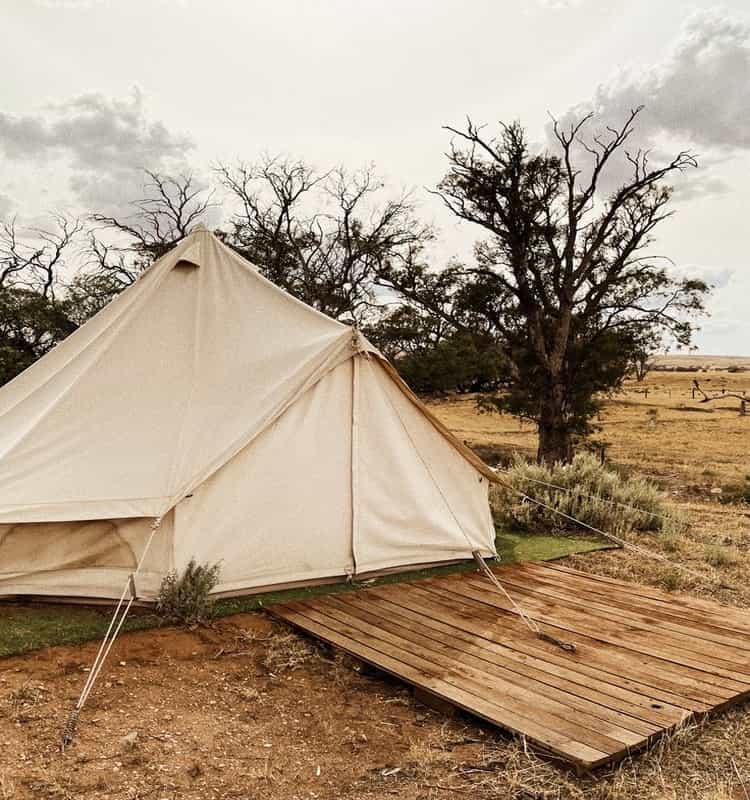How to dry out a tent
Never put a tent away wet if you can avoid it. Mould and mildew will mushroom on damp materials, leaving your equipment damaged, unusable and with a musty odour. If you leave it, you may have to replace your tent when you want to go camping again.
Even when you’ve waterproofed your tent, if you are camping in sometimes rainy climates (like the UK and Northern Europe!), it’s virtually impossible to dry out a tent before packing it away. With that in mind, here’s how to deal with your wet gear – both on site in a downpour and once you’re back home.

How to dry a tent in five easy steps
If it's pouring with rain when you’re packing up to leave the campsite, follow these steps:
1. Wipe any visible dirt and mud off your tent;
2. Unpeg and shake away excess moisture as best you can;
3. Pat it down with a clean, dry cloth – such as a highly absorbent microfibre towel – to get as much water out of the material as possible;
4. Pack your tent away loosely in a large plastic bag;
5. Be sure to air it properly as soon as you’re in a dry environment.
Drying a tent outdoors
If the weather permits, it’s best to dry your tent in situ – it will save future problems with mould and will also be lighter and easier to handle and pack away. Otherwise, you’ll either need to find some sort of shelter in which to dry your tent out, or take it home after following the five easy steps above.
Air your tent in the sun
When the rain stops, the fastest way to dry out your tent is to get it into the sun in a spot where there’s a decent airflow as well.
1. If you’re lucky enough to hit a warm day, move a free-standing tent to a sunny patch and open all the doors and windows to allow air to circulate; turn it on its side to allow the bottom to dry out too.
2. For all other tents, remove the protective flysheet and spread it out either over a branch or on a sunny piece of ground. Turn it over from time to time so that both sides dry quickly.
3. If your camping gear and clothes are soaked too, get them out and lay them in the sun to dry.
4. Open every window and door in the tent to get the air moving through it; a decent airflow will dry it out as fast as possible.
5. If there is standing water inside your tent, use a microfibre towel to wipe it away.
Drying a tent in the rain
Still wet? If you’re camping in the rain and your tent is soaked, you’ll need to move it to some sort of shelter to try and dry it out. If that’s not possible, the only answer is to wait until the weather improves. Covering your tent with a protective tarpaulin sheet will go some way towards protecting it from the rain.
1. First things first: move all your camping gear and clothing out and store it safely under the shelter or in your car.
2. Next take the tent down and hang its various components up to dry on a makeshift clothesline, pole or tree branch.
3. Wipe off any excess water with a microfibre towel, and open all the doors and windows to get fresh air circulating – this will help to evaporate the water on your tent.
4. If your tent is free standing, leave it set up and move it in its entirety under the shelter to dry out.
Drying a tent in winter
It can be challenging to keep your tent dry if you are camping in winter. When the weather is bad, brush snow or excess water from the outside of the tent and dry the inside with a microfibre towel. Pack it up loosely in a large plastic bag if you need to get it home, then spread it out as mentioned in How to dry a tent in five easy steps. Airflow and breeze will do the rest, but it will take longer to dry out completely than in summer.
Drying a tent indoors
So you had to bring your tent home before it was dry. Get it out of its protective plastic bag to dry as soon as you can to prevent mould forming on the fabric.
1. If it’s still raining and you have space available, hang it up in the shower, garage, shed or utility room.
2. Wipe any excess water off and place towels underneath the tent to absorb any drips.
3. Spread out all the different components, from the flysheet to the groundsheet, across different parts of the house that can provide drying room.
4. If possible, use a floor fan or a dehumidifier to speed up the process. If the rain stops, open all your windows and doors to increase the airflow around the drying tent.
5. Even when you think your tent is dry, double-check tight corners, such as those around seams and zips, as damp can get trapped in small spaces.
6. If the weather does clear up, and you have outside space, pitch your tent in the garden. Open all the doors and windows to increase airflow, which will help it dry out faster.
Five places to dry a tent in a confined space
If you’re short on space for drying your tent, try the following.
1. A shower cubicle;
2. Over a curtain rail;
3. Over the backs of two or three chairs;
4. Over a kitchen table;
5. On a clothesline (but do ensure that the line is strong enough to take the weight of your wet tent).
How to dry a canvas tent
Cotton-based canvas tents are more durable than their synthetic counterparts but usually absorb more water. If you have a canvas tent, use the same methods as above to dry it, but keep in mind that it will take longer and will be considerably heavier. Canvas can take between 24 hours and two days to dry out when it’s very wet. Remember to wipe the underside of the tent with a microfibre towel before putting your canvas tent away, so the wet base does not re-soak the canvas.

Five popular types of canvas tent
Popular with glamping families, canvas bell tents utilise a single pole to support the main canopy, which is anchored by numerous tie downs.
A compact tent that’s easy to fold away and transport; often used by solo or wild campers.
Another tent popular with glampers for its unusual conical, windowless structure, which retains heat well.
Sturdy structures with strong wooden poles covered by thick canvas, with plenty of floor space and head height making them popular for family holidays.
Circular tents traditionally used as portable accommodation by nomadic peoples on the Mongolian steppes, yurts are now available universally. Originally made of animal hide, today they are commonly made from canvas.
What not to do when drying a tent
As well as understanding how to dry out your tent, it’s worth knowing what to avoid.
-
Don’t use direct heat sources like a hair dryer or tumble dryer as these could degrade the fabric. If you’re drying your tent indoors, popping a fan on a cold setting and opening the windows can speed up the process.
-
Don’t wait to dry out your tent. The longer you leave it wet, the more damage is done. Mould and mildew can develop in as little as a single day.
-
Don’t dry out the tent in its bag. This will trap moisture, increasing the risk of fungi spores multiplying.
How long does a tent take to dry?
It can take between a couple of hours and two days for a tent to dry thoroughly. Obviously this depends on material and moisture levels, but as a general rule of thumb, the longer you can leave your tent out to air the better. It should only take a couple of hours to dry on a warm day if it's made from a lightweight synthetic fabric like nylon.
One useful tip for speeding up the process is to renew the tent's waterproof coating regularly. Moisture will then bead and run off the flysheet instead of soaking right through the material, so it won't get as wet in the first place.
In conclusion, the most important fact to remember is that you should never pack away your tent wet unless you really have no other option. And remember, once it is dry, you can follow these simple rules to keep your tent clean and in top condition.
FAQs
How do you dry a tent fast?
Tents tend to dry more quickly when pitched. Move your wet tent to an exposed, windy area to air it faster, or set it up in the sun for a brief period of time. Just be aware that the longer you leave it exposed to UV rays, the more they may degrade the tent’s flysheet.
Can you put your tent in the dryer?
No, a tumble dryer is too hot and intensive for your tent. It could ruin the fabric and zippers (not to mention your machine). You should avoid putting it on a low heat cycle, too.
What do I do when my tent is dry?
Once your tent is bone dry, you’ll need to take it down and store it properly. And if you made the mistake of leaving your wet gear packed up for longer than a couple of days, here’s our expert advice on removing mould and mildew.
How long does a waterproof tent take to dry?
It should only take a couple of hours to dry on a warm day if it’s made from a lightweight synthetic fabric like nylon, although heavier canvas can take around two days to dry out when it’s very wet.